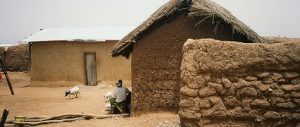The heart of Nandom is a fork in the road. It is here, in one of the northernmost towns in Ghana, that the buses come and go. You would call it a station if it was anything more than a triangle of reddish dust, surrounded by fast-food stalls, general stores and the rural bank. Once a week, a market sets up. The rest of the time, it’s the buses themselves, privately owned mini-vans known as “tro-tros”, daubed with prayers for the road – “Lord Have Mercy”, “My Redeemer Liveth” – that provide the action: the logic-defying piling on of people and goods, the waiting, in midday temperatures of 40° Celsius, for enough passengers to fill a van.
The buses are important to Nandom, the administrative centre for more than 50,000 people – chiefly farmers – in one of the poorest corners of Ghana, because the population is leaving. Migration has long been part of life in the dry reaches of west Africa, but in recent years, with economic development taking place elsewhere and erratic rains making rural life increasingly difficult, more and more people are taking to the road. The figures are inexact, but about 20% of those born in northern Ghana are now thought to live in the richer, more urbanised south.
In Nandom, the numbers are much higher: half the population has gone. People from the town offer varying reasons for the exodus – lack of jobs, enticing “greener pastures”, deteriorating climate – but they agree that it cannot go on indefinitely, this whittling, or Nandom will never prosper. “What is happening,” a local priest told me, “is that our society is to a certain extent being disintegrated.”
I went to Nandom to try and understand a phenomenon known these days under names that combine words like environment, migrant, displaced person and refugee. In short, the idea that climate change is going to displace millions of people. Since 1990, when the Intergovernmental Panel on Climate Change (IPCC) predicted that “the gravest effects of climate change may be those on human migration”, the prospect of rising seas, spreading deserts and a concatenation of natural disasters has been accompanied by the image of people on the move.
The logic is powerful: 10% of the world’s population would be inundated by a one-metre rise in sea levels – possible by the end of this century – while another 30%, more than two billion people, live in drylands, like Nandom, that are vulnerable to endemic drought. All these people, the argument goes, will have to end up somewhere. In February, the British ecologist James Lovelock suggested that they might come to Britain, and that the United Kingdom will become a “lifeboat nation” of migrants.
Estimates of the number of environmental refugees in 2050, when the global population is expected to peak at nine billion and the planet is forecast to be in the throes of a 2°-or-more temperature rise, vary between 50 million and one billion people. But the most commonly repeated number – included in Britain’s 2006 Stern Review [on the economics of climate change] – is between 200 million and 250 million, or around 10 times the number of refugees and internally displaced persons in the world today.
The numbers are enormous, the scenarios abstract. And until 2005, for most of us, they remained on the screens of Hollywood disaster films such as The Day After Tomorrow, in which American climate refugees pile across the Rio Grande, seeking shelter in Mexico. But then came Hurricane Katrina, and the displacing power of nature was made plain.
A category 3 storm, striking a city whose vulnerability was well known, in the world’s richest country, managed to cause the largest movement of people in the history of the United States. In 14 days, 1.5 million people – three times more than moved during the great Dust Bowl migration of the 1930s – fled the US coast of the Gulf of Mexico. Half the 2005 population of New Orleans, some 300,000 people, still have not come back.
Nothing spectacular like this has happened to Nandom, even if, like New Orleans, half the people are gone. “Our trees are still standing. Our trees are not capsized,” one farmer told me. “You cannot see it. You can even live through it and not see it. It is only when you sit down and think that you realise.”
And that is why places like Nandom rarely get written about. Most stories about environmental migration have focused on three or four so-called “canaries”: the first human habitats set to disappear. These range from the village of Shishmaref in Alaska, which is falling into the sea, to entire states, like the low-lying Maldives, which now has a fund to buy land abroad for its 400,000 citizens.
But these stark cases do not represent the future facing most people who might become climate migrants. Friends of the Earth, which shares the 250 million estimate of environmental refugees by 2050, puts the total number of displaced people from small island states like the Maldives at one million.
The other 249 million will come from humdrum places more like Nandom: poor, agricultural societies that have existed for a long time in marginal climates, with little room for error, but now find themselves struggling to support their populations. It is here that the real numbers – the tens of millions of potential migrants – lie and yet it is also where the future is hard to read, where there is hope still, and where climate change is often taking place among other profound transformations, such as economic development, rapid population growth or political upheaval.
This interplay of factors makes it difficult to imagine what environmental migration is going to look like. And since the early 1990s, when migration emerged as a logical corollary of climate change, academics have argued about how best to approach the problem. On the one hand, there is the sheer enormity of human movement. According to Professor Norman Myers, a British academic who has done more than anyone to raise the alarm over climate migration, this alone will be enough to overwhelm the world’s current refugee laws and humanitarian agencies.
“We do not seem to have the institutions in place that can measure up to a challenge like this,” Myers told me. “We are talking about big numbers,” he said. “I will be very surprised if there aren’t eventually half a billion of these environmental and climate refugees, and that will alter the basic demographics of a lot of countries.”
Seen from this angle, the scale of future migration will be enough to cause a pulse-quickening mixture of humanitarian emergencies and security breakdowns. And Myers has argued that the world’s richest and most ecologically stable countries will come under increasing pressure to accommodate those seeking safety.
“Developed countries cannot isolate themselves from distress and disaster in developing countries,” he wrote in 2005. “Already there are sizeable numbers of environmental refugees who have made their way, usually illegally, into OSCE [Organisation for Security and Co-operation in Europe] countries – and today’s stream will surely come to be regarded as a trickle when compared with the floods that will ensue in decades ahead.”
Cutting against the anticipated scale of environmental migration, however, is the variety of ways in which it might unfold. And this makes it hard to treat as a single problem. Climate change is expected to hit different parts of the world in different forms and at different speeds. The spectrum is enormous. It stretches from increasingly frequent sudden disasters, such as Katrina, to cases like the African Sahel and Australia’s Murray-Darling Basin, where drought and wildfires threaten large-scale forced migration over the next 30 to 40 years.
Then there are the Nandoms, the marginal zones where millions of people are hanging on in increasingly inhospitable climates. While at the far end of the scale, a sea-level rise of three millimetres a year (its current rate), or even considerably more, will play out over generations – the “migration” of a coastal community might be no more than the changing shape of their city. All these scenarios will involve the movement of people, but beyond that, how far do the similarities extend?
For some, this has made the very notion of “environmental migration” misleading. Richard Black, a professor of human geography at the United Kingdom’s University of Sussex who has studied the question for the United Nations High Commissioner for Refugees (UNHCR), told me he had several problems with the idea. In the first place, he said, it has been used to raise the spectre of massive international migration, even though people displaced by environmental disasters overwhelmingly tend to stay within their national borders, often as close as possible to their former homes. This can still be a great strain, but it is not the same as hordes of people crossing borders.
It is also, incidentally, how migration from northern Ghana is playing out. A survey of 204 families in Nandom in 2004, for instance, found not a single relative among them who had migrated outside the country.
More broadly though, Black disputes the idea that environmental migration is somehow new, or different to other kinds of migration. The decisions of every migrant, he argues, even those made under great stress, are shaped by a mixture of economic, social and cultural factors, and the environment is just one of these. By imagining that climate change has some kind of special influence over migration, Black argues that we run the risk of overlooking similarities between people who move for environmental reasons and those who move for political or economic reasons, and those who do not move at all. The scale of impending migrations may be alarming, but that does not mean they are exotic, or should be treated in isolation.
“Assuming that an exceptional event must have exceptional causes is sloppy,” said Black. “It’s sloppy thinking.”
The clashing interpretations of Myers and Black are important because, between them, they will shape how environmental migration is tackled and researched over the coming years: as security threat, humanitarian crisis or another piece of the development conundrum. So far, however, the result has been a stalemate. In the last major report by the IPCC, in 2007, the two approaches cancelled each other out. Unable to decide who was right, the IPCC predicted that nobody would be displaced by climate change at all.
Despite what the IPCC says, the buses have continued to leave Nandom. I arrived in the town in March, expecting the landscape to look drier than it did. The bus journey from Wa, the capital of Ghana’s Upper West region, revealed a savannah as we approached the town: arid, golden grasses and humps of earth, waiting for planting. But the dust was shot through with green. This, I later found out, was because there had been a downpour in January, a full three or four months before the normal start of the rainy reason and another confusing note in the region’s discordant climate.
Unpredictability is Nandom’s problem. The 1990s were a decade of steady, improving rains in northern Ghana, but since the turn of the century, the seasons have lost their shape. The region’s historic five-month rainy reason, from March to August, has shrunk to just two or three months, but sometimes with just as much, if not more, rain. Last year 95 millimetres of rain – 10% of Nandom’s annual total – fell on a single day in August, destroying crops and houses. Flooding, normally unheard of in northern Ghana, has occurred in each of the past two years, with the UNHCR coming to the help of 75,000 people in 2007.
The volatility is here to stay. Climate models predict a one- or two-degree rise in temperature in Ghana and west Africa by mid-century and a simultaneous 10% decrease in rainfall, but the line is a jagged one. Zinedeme Minia, the deputy director-general of Ghana’s Meteorological Agency, told me it was much easier to map 20- or 30-year trends than to know what will happen in the shorter term. “Climate change will bring surprises,” he said. And for poor farmers who rely on rain-fed agriculture, that uncertainty is too much to bear. “You are doing a gambling game,” said Minia. “You are never sure when you are likely to get something and when you will lose completely. That is the issue.”
Farmers in Nandom spoke in alternating tones of fatigue and bloody-mindedness about their capricious rains. One day, around noon, I met Leo Yiryel, the 84-year-old chief of a small village just outside the town. “The rain is punishing us a lot,” he said. “There used to be only a hard dry season, but now there is also a rainy season that can destroy your crops.”
Yiryel was sitting on a bench under a mango tree, surrounded by grandchildren who listened raptly. There seemed to be dozens of them so I asked Yiryel where their parents were. He told me he had 12 children – a 13th died young – and that 11 of them had migrated to southern Ghana. “I never expected that,” admitted Yiryel. “I thought when they were in school and in training that all the jobs and opportunities would be here, but they are not. They are all down there.”
But some are determined, whatever Nandom’s future, to stay. Later that day, I went to Brutu, a village with a dam, where farmers try and grow vegetables all year round. But this year, in the depths of the dry season, the water had run out. I found Isaac Abeikpep surrounded by tomatoes, cabbages, peppers and yoro, a local fruit related to the watermelon, all dying.
“The land is not all that good,” Abeikpep said, but he wasn’t going anywhere. “I have too many mothers and grandmothers.” Abeikpep, who is 29, vowed he would never leave his plot, but talking about the months ahead, he could not suppress his anxiety. “I hope this year will be okay,” he said. “But the longer you hope, the more you realise that you will be disappointed.”
Nandom as a whole, however, is doing more than hope. The district has been taking measures to adapt to its hostile climate since 1973, when the local Catholic church set up the Nandom Agricultural Project to help farmers improve their agricultural techniques. The date is significant because it relates to the sub-Saharan droughts of the 1970s and 1980s, which killed an estimated 100,000 people in west Africa and triggered the migration of more than a million people from the worst-affected countries of Mali, Niger and Burkina Faso to their southern neighbours, mainly Ivory Coast and Ghana. In Nandom, the struggle to cope with a marginal climate has been going on for decades.
For much of that time, the struggle has been led by Stanislaus Nasaal. Sitting in the offices of the Nandom Agricultural Project, with last year’s rainfall statistics posted on the wall, Nasaal said that farmers were adapting to shorter growing seasons with new crops – quicker-maturing millets and maizes – and new methods of planting. Unsure of the rains, farmers now spread their seeds among ridges, hillsides and low-lying ground to improve their chances of withstanding droughts, floods, or both. “We can always mitigate,” said Nasaal several times, as if it was a chant. “We can always mitigate.”
As we discussed adaptation, I noticed that migration, in various forms, kept coming up. One of the new tilling techniques in Nandom, for example, in which farmers look for inclines in their fields and then build earth ramparts around each seed to catch water, is from Burkina Faso, courtesy of the migrants who fled the droughts there a generation ago. More often, though, Nasaal mentioned migration as a way of helping families spread the risk of farming in such uncertain conditions.
Relatives are sent away to the farms and cities of southern Ghana to find a steady income. “If we are two brothers,” said Nasaal. “I will go in case you fail. We will complement each other.”
NEXT: To leave or to stay?
Sam Knight is a regular contributor to FT Weekend Magazine.
This article was first published in the FT Weekend Magazine on 20-21 June 2009.
www.ft.com/home/uk
Copyright The Financial Times Limited 2009
Homepage image by zug55



